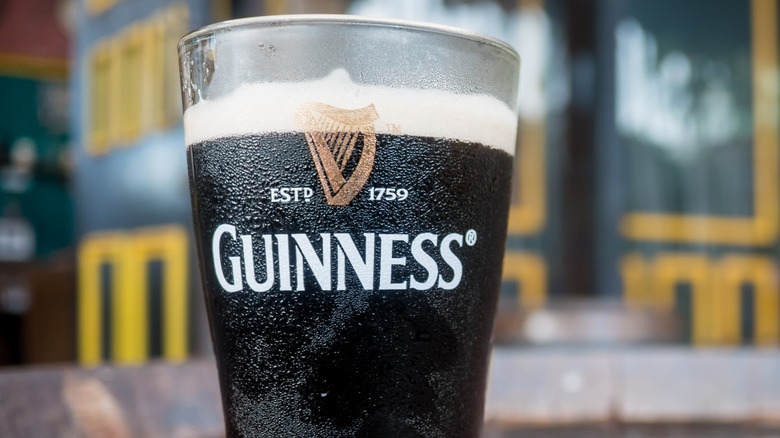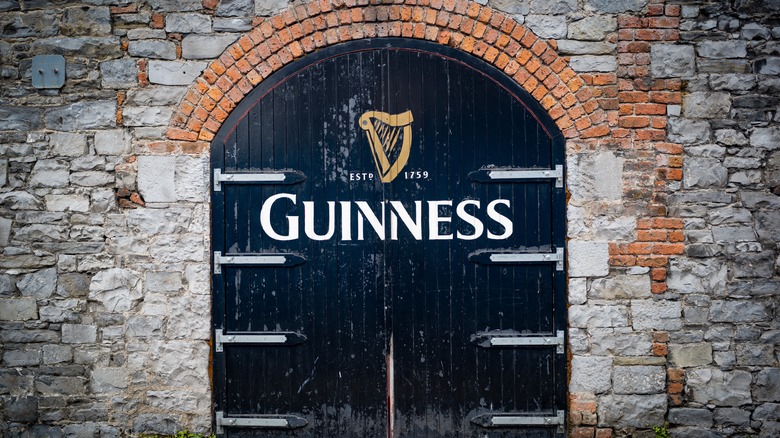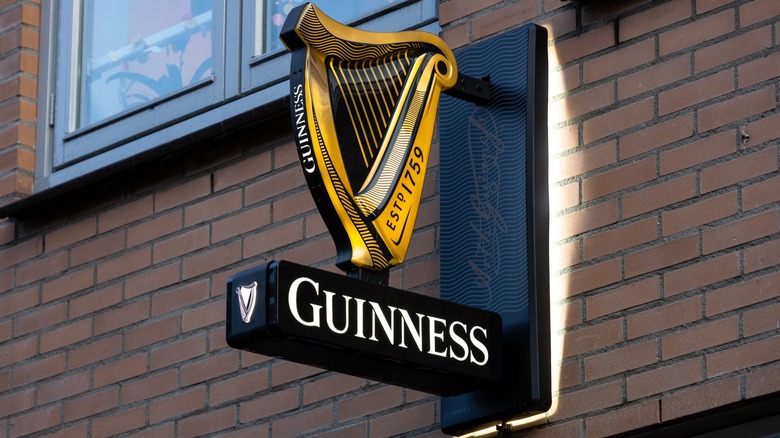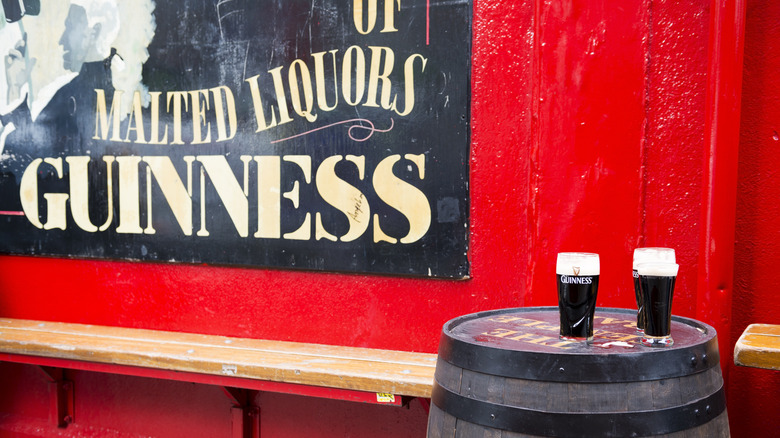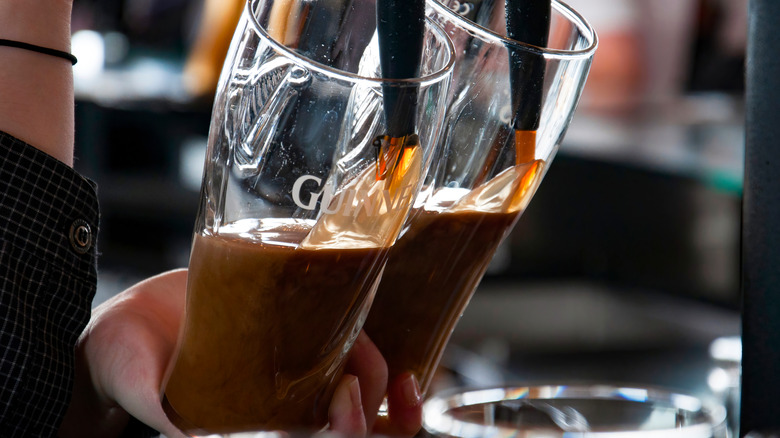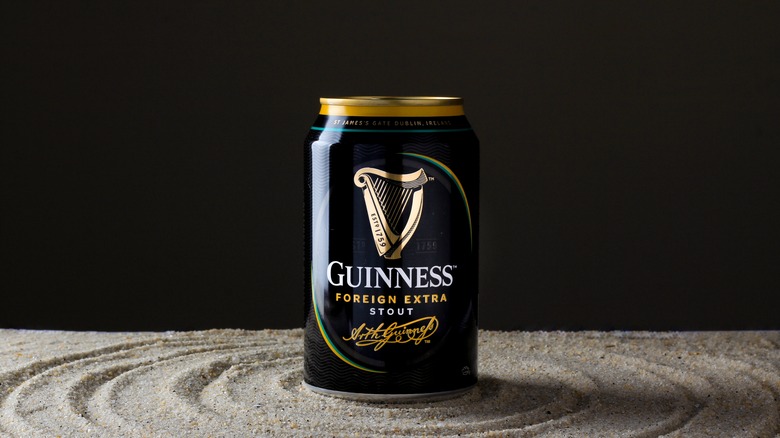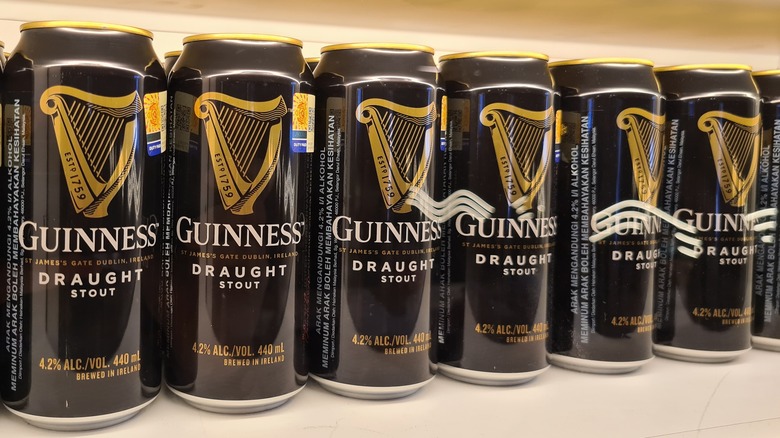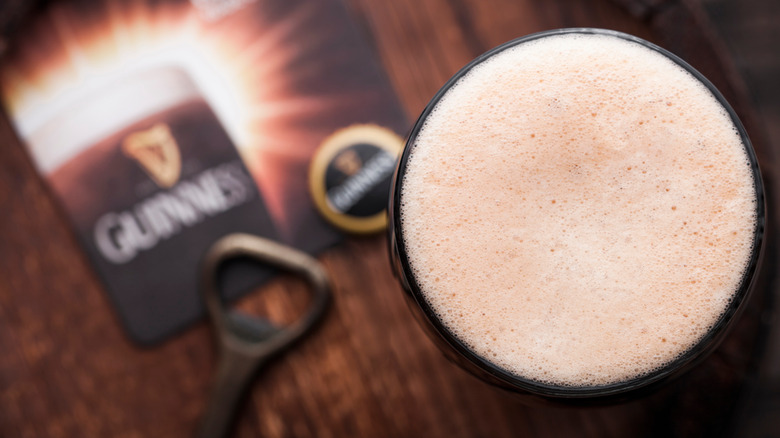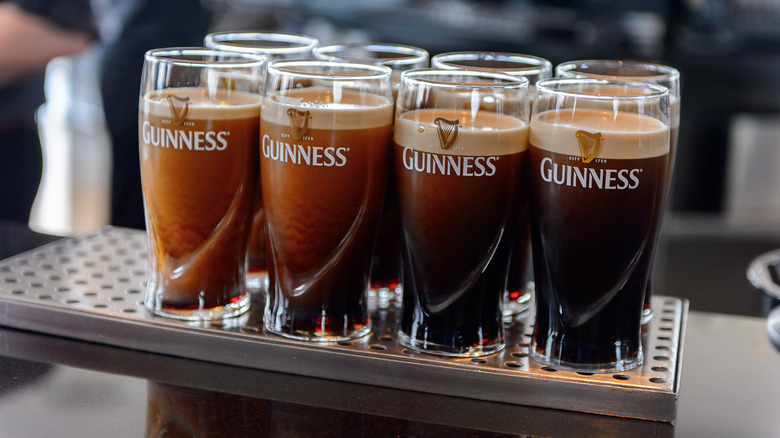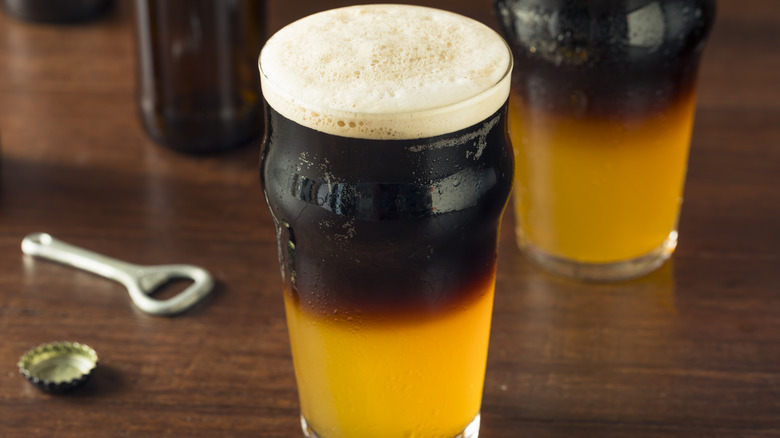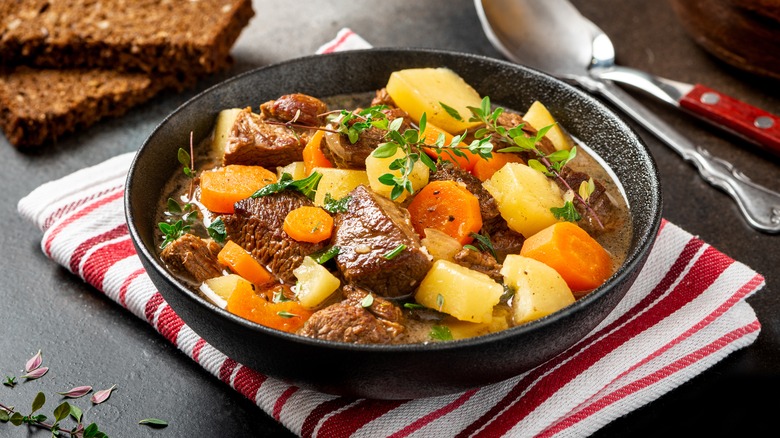11 Things You Probably Didn't Know About Guinness
For most casual beer fans, the iconic Irish stout Guinness is a once-a-year, St. Patrick's Day treat. With its deep, reddish-black color, its thick, creamy head, and its intensely toasty, malty flavor, it offers a way more intense drinking experience than the usual American lager. It's definitely a beer to be sipped and savored, rather than chugged. But, while it makes a big impression on the palate, Guinness is, surprisingly enough, lower in alcohol content than many lighter, easier-drinking beers: Guinness Draught has 4.2% alcohol by volume, while Budweiser clocks in at 5%.
What makes Guinness even more interesting is its history, which is just as rich and fascinating as its flavor. Founded in Dublin in 1759, it's one of the world's oldest continuously operating breweries. Soon after its founding, Guinness established a local reputation for more-than-respectable brews. But, Guinness didn't start making its iconic stouts until nearly 40 years later in 1798. This was when local brewers discovered that aging darker malts, which had previously been considered too harsh and bitter for quality beer making, rendered them (and beers made from them) smooth and flavorful. The new, nearly black Guinness stout was an instant hit, so much so that within a year, the brewery stopped producing other varieties of beer. Today, the Guinness brewery in Dublin has become a bucket-list destination for all beer lovers (the fact that tours include a pour of the foamy stout only sweetens the deal) and is a favorite at pubs around the world.
Guinness' founder signed a 9,000-year-lease on his brewery
Starting a new business always requires a leap of faith. But, Arthur Guinness had plenty of advantages when founding his eponymous brewery in 1759 — a generous inheritance from Arthur Price, the Archbishop of Cashel, for whom Guinness' family worked as groundskeepers for many years. Guinness also had a wealth of brewing know-how picked up from his father, who is thought to have been responsible for brewing beer for Price's estate. All of this must have given him a supreme sense of confidence, for he not only paid for the dilapidated St. James Gate brewery (named for the medieval gate leading into Dublin) but boldly signed a 9,000-year lease on it.
While the brewery was officially his for the foreseeable (and maybe not-so-foreseeable) future, this didn't mean things always went smoothly for Guinness. The lease allowed a supply of water, but as the brewery grew and its water consumption increased beyond what the Dublin Corporation considered acceptable, the corporation attempted to cut the brewery off. Guinness was predictably displeased by this turn of events, and the disagreement culminated in a physical confrontation in which Guinness wrested an axe from a corporate representative, swearing that he would keep his water supply. Whatever he did must have worked, since by 1838, Guinness had become the largest brewery in Ireland.
The Irish Free State changed its symbol to avoid impinging on Guinness' trademark
By the 1860s, Guinness had grown from a local and regional favorite to a global brand, with barrels of its beer being shipped around the world to thirsty fans. The Guinness company, which remained family owned, wanted to be sure that the world never forgot it was a proudly Irish company making distinctively Irish brews. The family thus chose a harp, which they felt exemplified Irish culture at its best, as its new trademark. And, while the harp has remained a constant in Guinness' branding, it has changed form over the years, becoming more streamlined and losing strings as graphic design trends evolved.
When the Irish Free State was established in 1922, it faced a similar challenge: Find a symbol that best represented everything Irish. It too decided on a traditional Irish harp, but there was an obstacle, as Guinness had already trademarked the iconic symbol. Not willing to give up their choice of symbols, the Irish Free State (which later evolved into the Republic of Ireland) instead got by on a technicality. Today, a harp appears on Irish coins and paper money, as well as on the cover of Irish passports. But, observant beer lovers will notice that the official Irish harp is facing the opposite direction as that on the Guinness label.
Early Guinness employees traveled with exported beer to monitor its quality
Today, Guinness is manufactured in authorized breweries around the world, where local teams manage production and ensure quality consistency. In the 1890s, when Guinness was still gaining global popularity, all of it was still being made in Dublin. This meant that getting Guinness to far-flung locales in Africa, Asia, and the Americas meant transporting it by boat, which at the time was a lengthy and potentially dangerous process not only for sailors but also for the transported beer, which could be exposed to less-than-optimal storage conditions during its lengthy journey.
This wasn't just a logistical problem for Guinness, but a serious, reputational risk — no self-respecting brewer wants to serve the world spoiled beer. So, Guinness did the only thing possible at the time and sent dedicated monitors along with the beer on their long journeys to keep an eye on how it was being stored and ensure its quality before releasing it upon arrival. And, some of these agents took their quality control duties beyond seriously, even checking for proper serving conditions at the point of sale in far-flung ports. "I am pleased to say that it was a treat to see the condition in which the Stout is drawn, all from ice-boxes at a temperature which made the article extremely palatable," agent Arthur Shand wrote of his 1911 trip to Boston.
The Guinness Book of World Records started as a promotional giveaway for the brewery
Besides enjoying a drink, another longstanding pleasure of visiting a favorite brewery or pub is engaging in pointless arguments about utterly unimportant matters: How big is the world's biggest ball of yarn? Who won the most Olympic medals, and for what? Today, many breweries channel the common impulse to ponder pointless facts while drinking into formal trivia nights complete with official teams and prizes. In the pre-internet days, barroom debaters had no easy way to confirm who had gotten their facts right — any nearby libraries were probably closed by the time most alcohol-fueled debates got underway.
One such debater was Sir Hugh Beaver, then Managing Director of the Guinness Brewery, who, in the early 1950s, found himself in a heated debate about which was the fastest game bird in Europe. No one could find a definitive answer, but this gave Beaver an idea: Since people always get into arguments in pubs about which things or people are the biggest, smallest, fastest, or slowest, why not put together a definitive compendium of answers for pub-goers and use it to promote Guinness? He hired Norris and Ross McWhirter, a pair of twin brothers who were professional fact-checkers, to write the book. Today, the Guinness Book of World Records has taken on so much of a life of its own that its historic link to Guinness beer could itself be a barroom trivia question.
Does the traditional Guinness two-part pour make any difference?
When dedicated fans of Guinness order a pint, they watch closely as their pint is drawn. By custom — as well as by the recommendation of Guinness itself — Guinness should be poured in two stages. First, one should fill it ¾ of the way, at which point foam will surge from the glass. Next, one should wait for the foam to settle before resuming the fill. The historical reason for this was that Guinness was originally poured from two casks, one containing younger beer and one containing older, more aggressively carbonated beer. The two-step pour was devised as a way to ensure a head of proper proportions when switching between casks.
In the 1950s, Guinness developed a method for carbonating its stout that eliminated the need for the two-step pour. Yet, even today, Guinness aficionados insist that pouring a pint in a single draw would result in an overly large head. The ideal head thickness for a pint of Guinness, according to Guinness brewmaster Fergal Murray, Guinness' master brewer, is between 11/16" and 12.5/16". A test of the traditional pouring method versus two other methods showed that the traditional method produced the ideal head size, while the others produced larger heads. But another, less formal, blind test found that even dedicated Guinness fans couldn't taste the difference. So, perhaps it's best to appreciate the traditional pour as a historical ritual, rather than a requirement for a tasty pint.
Guinness is enormously popular in Africa
In the imagination of the American beer drinker, Guinness is indelibly identified with Ireland; indeed, the brand is a big point of pride for the Irish. But, an equally, if not more, enthusiastic group of Guinness fans comes from an unexpected locale: Africa. "I've talked to Nigerians who think of Guinness as their national beer," Fergal Murray, a Guinness brewmaster who had worked in the company's Nigeria brewery, told Smithsonian Magazine. "They wonder why Guinness is sold in Ireland."
The roots of Africa's fondness for Guinness date back to the early 19th century, when Arthur Guinness II took over brewery operations from his father. The younger Guinness set his sights on global domination, and soon Guinness was being exported to British colonies in the Caribbean and Africa. The beer sold overseas, however, differed slightly from that found in Irish pubs — it had more hops (which serve as a preservative as well as a flavoring agent) and a higher alcohol level, both of which helped preserve the beer's quality during its long shipping times. In addition, the Guinness Foreign Extra Stout now sold in Africa differs from that sold elsewhere in the world: It's made with local maize or sorghum (both ingredients in traditional African beers) instead of barley, which lends a slightly bitter taste. And, it's all brewed locally; Guinness boasts 13 breweries in Africa today.
Guinness was once marketed as a health drink
Guinness may be a drink of celebration and leisure, but there's something wholesome and comforting about its taste. The creaminess of the foam feels substantial and filling, and the rich toastiness of it can make you feel like you're drinking the best brown bread ever. Guinness historically capitalized on (and likely, sincerely believed) its stout's reputation as a wholesome form of nourishment, even using the advertising slogan "Guinness is good for you." The drinking public and even healthcare professionals bought this, and doctors in Ireland once recommended that nursing and pregnant women drink it to maintain their strength and improve lactation.
And, there might be a bit of truth in these old claims. Guinness was found to have a higher level of folates, a form of Vitamin B that enables cells to divide, than other beers. In addition, it was found to contain more fiber than other beers, since it contains more fiber-rich, un-malted barley than many other beer varieties. While it feels richer on the tongue than many beers, Guinness is lower in calories than even lighter-tasting beers such as Bud Light and Heineken. None of this, however, makes Guinness a health food. Today's doctors warn that alcohol should be consumed only in moderation (if at all), and alcoholic drinks are a definite no-go if you're nursing or pregnant.
Here's why there's a plastic ball in Guinness cans
Opening a can of Guinness Draught for the first time, you might find a couple of surprising things: For one, the beer will come out with an unusually creamy, tight head — not far off from what you'd get if you ordered a pint from a tap in a good Irish pub. Second, you'll notice a small, plastic ball rattling around inside the can. These two points are related –—the ball (which Guinness calls "the widget") helps generate the characteristically creamy foam by introducing nitrogen into the beer.
Some Guinness fans may be surprised to learn that the widget isn't nearly as high-tech as they might think. While it's commonly believed that the plastic ball is charged with nitrogen gas that's automatically released when the can is opened, in reality, empty widgets are simply placed in the unfilled cans. When the cans are filled, pre-carbonated beer fills both the can and the widget, and the cans are further pressurized before sealing. When you open a can, the reaction between the air inside and outside the can forces gas and beer from the widget, contributing to the extra surge of creamy foam. This elegantly simple innovation was impressive enough to be voted the most important invention of the 20th century in an Irish magazine survey. (The internet came in second.)
Guinness' founder was a respected philanthropist
At first glance, Guinness founder Arthur Guinness could seem like the last person one would expect to become an Irish icon. As a Protestant in a majority Catholic country and a loyal unionist at a time when calls for Irish independence were gaining steam, he gave his neighbors plenty of reasons to distrust him. But, one thing they couldn't deny was that he made darned good beer, and that was enough to engender significant goodwill.
An even more important reason Guinness gained so much respect, however, was his dedication to the welfare of his workers. Exceptionally progressive for a factory owner of the time, he paid his staffers 10% more than the average wages for contemporaneous industrial jobs. In addition, he offered benefits to his workers that included paid vacations, a medical clinic at the factory for both workers and their families, as well as pensions, free meals, and even a beer allowance. Despite being a bit of an outsider, he was active in community philanthropy, founding Sunday schools in Dublin. He also served on the board of — and later became governor of — a hospital serving poor populations in Dublin. His descendants continued his tradition of philanthropy, and the Guinness brewery continues to sponsor efforts such as the Water of Life initiative, which is dedicated to ensuring supplies of safe drinking water in Africa.
Guinness is a great addition to cocktails
Guinness is flavorful and substantial on its own, and for many fans, it's their beer of choice. But, people soon discovered that it makes a great mixer, as well. Curious drinkers — especially those who found Guinness too intense to enjoy on its own — began experimenting with ways of cutting it other ingredients. Among the first recorded mixed drinks with Guinness was the black velvet, which combined one part Guinness and two parts Champagne. The drink was reportedly invented in 1861 in observance of the death of Queen Victoria's husband, Prince Albert. Another early drink, the black and tan, combines equal parts of Guinness and lager, making it an ideal drink for those who enjoy Guinness but are in the mood for something lighter.
Many modern Guinness cocktails take advantage of the stout's chocolatey, coffee-like notes to create sweeter combinations that can serve as drinkable desserts. A super-simple example of this is a Guinness float, in which a half-pint of Guinness is simply topped with a scoop of vanilla ice cream and (optionally) chocolate sauce. Another easy-to-make example is the Black Fog cocktail, which tops a glass of Guinness with a few splashes of raspberry liqueur. But, Guinness can also harmonize nicely with savory cocktails, such as Bloody Marys, where it adds extra depth to the Sunday brunch classic. Try this Dublin Redeye, which combines Guinness, Jameson, coffee, and serrano chilies into a unique drink.
Guinness is also a great flavoring for both sweet and savory dishes
Guinness lovers know that Guinness not only goes well with meals, but it makes a great addition to a surprising range of recipes, too. Of course, the first recipes most cooks think of putting Guinness in are prototypically Irish dishes such as beef stew and the Irish-American classic (virtually unheard of in Ireland) corned beef and cabbage. But, the rich, toasty flavor of Guinness is versatile enough to complement dishes from other culinary traditions. Combined with minced ginger, rosemary, honey, garlic, and passionfruit, it makes a flavorful marinade for grilled pork chops; mixed with brown sugar and mustard, it makes a tantalizing, sweet-savory glaze for fish.
Guinness can also enhance a wide range of desserts. Stir some into the sliced apples for a classic oat-topped apple crumble to add extra depth to the familiar sweet. Or, you can give a classic Guinness float a Caribbean twist by pouring Guinness Foreign Extra Stout over coconut ice cream and adding a splash of coconut rum. For a simple, portable dessert, Guinness brownies are always a hit.

